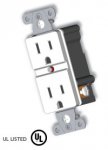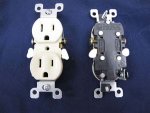You are using an out of date browser. It may not display this or other websites correctly.
You should upgrade or use an alternative browser.
You should upgrade or use an alternative browser.
Heat Detecting Outlet
- Thread starter Cletis
- Start date
- Status
- Not open for further replies.
ptonsparky
Tom
- Occupation
- EC - retired
They make them now. Called a fuse. Thermal cutouts. Fuse links. Etc.
Never mind, I thought I was onto something again. These guys beat me to the punch
http://www.bsafeelectrix.com/products.htm
Maybe this will be minimum code in 2020
http://www.bsafeelectrix.com/products.htm
Maybe this will be minimum code in 2020
Attachments
Yeah, but you'd think the manufacturer would at least update their website. "Planned delivery 2010" on a website in 2014 does not instill confidence in the buyer.That is a pretty cool device.
I noticed that too. They probably didn't take into the account of HO's, GC's, and some electricians doing "bare minimum" and maybe were counting on it to be required in 2014 NEC. It's a great idea and I hope they can hang on and maybe get it manditory the next possible code cycle. I think it's a great idea but probably too expensive per unit
- Location
- Wisconsin
- Occupation
- PE (Retired) - Power Systems
It would probably not be able to protect against maybe 50% of the most likely faults - those caused by poor connections on the line side of the device.I think it's a great idea but probably too expensive per unit
readydave8
re member
- Location
- Clarkesville, Georgia
- Occupation
- electrician
"Most electrical fires result from fixed wiring . . ."--is that true? I'd always heard the opposite, most electrical fires caused by the stuff that's plugged in to fixed wiring.
mgookin
Senior Member
- Location
- Fort Myers, FL
"Most electrical fires result from fixed wiring . . ."--is that true? I'd always heard the opposite, most electrical fires caused by the stuff that's plugged in to fixed wiring.
http://www.usfa.fema.gov/prevention/outreach/electrical.html
I went ahead and took an excerpt from that link above and extrapolated a theory
- U.S. fire departments respond each year to an estimated 25,900 home electrical fires. These fires cause an estimated 280 deaths, 1,125 injuries and $1.1 billion in property loss.
- Thirty-nine percent of home electrical fires involve outlets and receptacles, electrical branch circuits (for example, interior house wiring), and other electrical wiring.
10,101 House Fires
109.2 Deaths
438.75 Injuries
0.429 Billion in Damages
Sounds like enough evidence to pass something like this to me?
K8MHZ
Senior Member
- Occupation
- Electrician
I went ahead and took an excerpt from that link above and extrapolated a theory
Therefore, 39% of above would be
- U.S. fire departments respond each year to an estimated 25,900 home electrical fires. These fires cause an estimated 280 deaths, 1,125 injuries and $1.1 billion in property loss.
- Thirty-nine percent of home electrical fires involve outlets and receptacles, electrical branch circuits (for example, interior house wiring), and other electrical wiring.
10,101 House Fires
109.2 Deaths
438.75 Injuries
0.429 Billion in Damages
Sounds like enough evidence to pass something like this to me?
The data is insufficient to tell us how many fires were caused by overheated receptacles.
The heat sensing receptacle will do nothing to stop fires from overheated extension cords or permanent wiring or overloaded circuits, which likely cause far more fires than anything happening at a receptacle inside a box.
The only time I have seen a receptacle actually get hot enough to catch fire it was used as a pass through. Pigtailing would have prevented the incident. The fire burnt through the side of the receptacle and smoke stained the wall above the cover, but no damage to the structure. When the receptacle burned, it melted a wire and shut the power downstream off.
On the same circuit I found one more receptacle that was getting hot enough to melt the plastic, but still worked. One screw terminal was loose, probably from years of thermal cycling. That was also used as a pass through ahead of where the space heater was plugged in.
A better code change would be to not allow receptacles to be used as pass through devices.
The data is insufficient to tell us how many fires were caused by overheated receptacles.
The heat sensing receptacle will do nothing to stop fires from overheated extension cords or permanent wiring or overloaded circuits, which likely cause far more fires than anything happening at a receptacle inside a box.
The only time I have seen a receptacle actually get hot enough to catch fire it was used as a pass through. Pigtailing would have prevented the incident. The fire burnt through the side of the receptacle and smoke stained the wall above the cover, but no damage to the structure. When the receptacle burned, it melted a wire and shut the power downstream off.
On the same circuit I found one more receptacle that was getting hot enough to melt the plastic, but still worked. One screw terminal was loose, probably from years of thermal cycling. That was also used as a pass through ahead of where the space heater was plugged in.
A better code change would be to not allow receptacles to be used as pass through devices.
Actually, I agree with you. Your onto a great idea. What about incorporating receptacles 120V 15 and 20 amp cannot be used for pass through power? Maybe get ahold of levitan or PnS and have them go for a 2 screw (1 hot, 1 neutral) device with no back stab holes either ???
K8MHZ
Senior Member
- Occupation
- Electrician
Actually, I agree with you. Your onto a great idea. What about incorporating receptacles 120V 15 and 20 amp cannot be used for pass through power? Maybe get ahold of levitan or PnS and have them go for a 2 screw (1 hot, 1 neutral) device with no back stab holes either ???
I only have control over what I do. I am not good at trying to get rules changed. Not only that, there are many electricians on this site that think backstabbing and passing through are just fine.
I am also going to invest in a torque screwdriver so the receptacle screws are all torqued to spec. If the instructions call for a torque spec and it was ignored, that is a NEC violation. How many sparkies do you know that use a torque screwdriver?
Would the failures I witnessed had not occured if the screws were torqued properly upon installation? I am going to say no, they would have been fine.
Adding NEC rules because the ones that are already in place aren't being followed is really counterproductive.
K8MHZ
Senior Member
- Occupation
- Electrician
Here, like this one i've created
I appreciate your ingenuity, but all that will happen is that one screw will be used for two wires. I see it all the time on two screw receptacles with three cables going to them.
Remember, the Universe is winning.
Edit to add:
Change the design to a single wire backstab and use the same technology Wago does and you may be on to something. Selling it.....I don't know if EC's would find them all that appealing.
Last edited:
I believe "fixed" also includes wiring that has been messed with, for example every moved light fixture, and wires that have not been properly contained."Most electrical fires result from fixed wiring . . ."--is that true? I'd always heard the opposite, most electrical fires caused by the stuff that's plugged in to fixed wiring.
I think it also includes broken receptacles and outlets also. And let's not forget corrosion.
K8MHZ
Senior Member
- Occupation
- Electrician
I believe "fixed" also includes wiring that has been messed with, for example every moved light fixture, and wires that have not been properly contained.
I think it also includes broken receptacles and outlets also. And let's not forget corrosion.
In this case, I believe 'fixed' means permanently attached, as opposed to extension cords which are not. At least they aren't supposed to be.
readydave8
re member
- Location
- Clarkesville, Georgia
- Occupation
- electrician
39% of total fires from fixed wiring? Doesn't sound like most.
- Status
- Not open for further replies.



